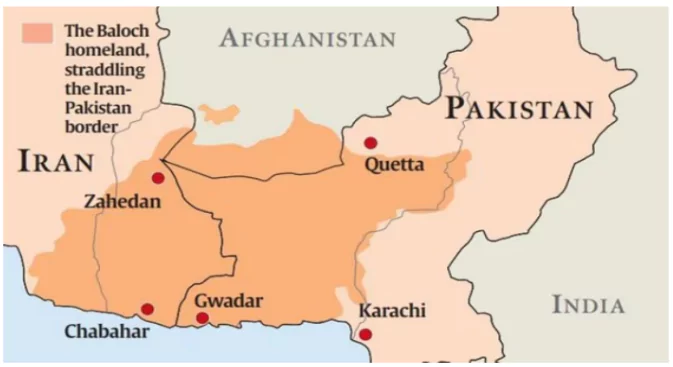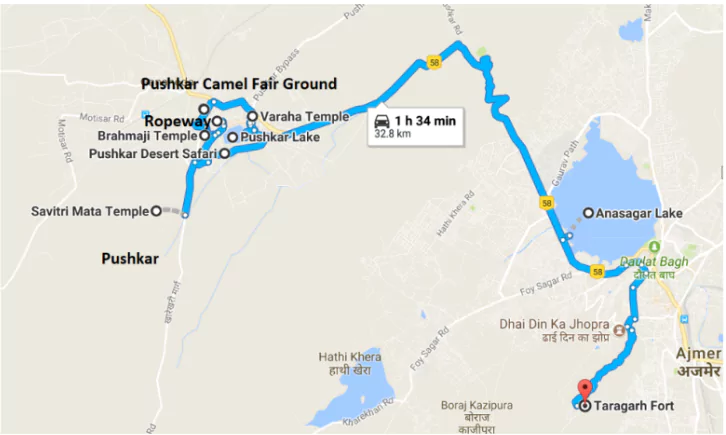Balochistan
Context: Militants of the Balochistan Liberation Army (BLA) hijacked a train (Jaffar Express) with 400 passengers between Quetta and Sibi.
About Balochistan
- Balochistan is Pakistan’s largest province.
- Balochistan is a historical region in West and South Asia.
- It lies in the southeastern Iranian plateau, bordering the Indian Plate and the Arabian Sea.
- The region is known for its arid landscape, consisting of deserts and mountains.

- Administrative Divisions
- Balochistan is divided among three countries:
- Pakistan: Province of Balochistan.
- Iran: Sistan and Baluchestan province.
- Afghanistan: Includes Nimruz, Helmand, and Kandahar provinces.
- It shares borders with:
- Pashtunistan (north),
- Sindh & Punjab (east),
- Persian regions (west).
- The Makran Coast lies along the Arabian Sea and the Gulf of Oman.
Other important points to note
-
- The Port of Gwadar is one of the world’s largest deep-sea ports and a future business hub.
- Major Cities
- Major river: The Hingol River is the longest and most significant river.
- Strategic Importance
- Located at the crossroads of the Middle East, Central Asia, and South Asia.
- Provides the shortest route from seaports to Central Asia.
- Lies near the Strait of Hormuz, a key global trade route.
Ana Sagar Lake
Context: The Supreme Court has directed the Rajasthan government to demolish the illegal Seven Wonders Park near Anasagar Lake, Ajmer within six months, citing environmental concerns and violations of wetland laws.
About Ana Sagar Lake

- Location: it is located in Ajmer district, Rajasthan, India.
- It is an artificial lake (man-made lake)
- Built By: Constructed between 1135-1150 AD by King Arnoraja (also known as Ana), grandfather of Prithviraj Chauhan.
- Historical Significance
- Mughal emperor Jahangir built the famous Daulat Bagh garden adjacent to the lake.
- Shah Jahan added five marble pavilions (Baradaris) along the lake, making it a popular tourist and heritage site.
- Getting its water from a seasonal river called ‘Luni’ Originating in the Aravalli range
Cyclone Jude hits Mozambique
Context: Mozambique, a southeastern African country along the Indian Ocean coast, has been severely impacted by Cyclone Jude, the third cyclone to hit the region this season.
About Cyclone Jude
- Origins of Cyclone Jude: Cyclone Jude was first identified as a depression on March 14 southwest of Diego Garcia in the Indian Ocean.
- Over the following days, it intensified into a moderate tropical storm, affecting northern Madagascar on March 15.
- Intensification and Landfall: As Cyclone Jude moved westward across the Mozambique Channel, it gained strength due to sea surface temperatures nearing 30°C, which provided the heat and moisture necessary for its growth.
Worldwide Terminology of Tropical Cyclones
- Typhoons: Occur in the China Sea and the Pacific Ocean.
- It commonly affects countries in East and Southeast Asia, including Japan, China, and the Philippines.
- Hurricanes: Found in the West Indian Islands of the Caribbean Sea and the Atlantic Ocean.
- Impact regions like the United States, Mexico, and Caribbean nations.
- Tornadoes: Occur in the Guinea Lands of West Africa and the Southern USA.
- Characterized by rapidly rotating columns of air extending from thunderstorms.
- Willy-willies: Term used in Northwestern Australia for tropical cyclones.
- Known for causing heavy rainfall and strong winds in the region
India’s First PPP Green Waste Processing Plant in Indore
Context: Under the Swachh Bharat Mission-Urban, Indore is poised to achieve a major milestone with the launch of India’s first green waste processing plant, developed through a Public-Private Partnership (PPP) model.
- About Green Waste: Green waste refers to biodegradable organic waste derived from plants and natural vegetation.
- It includes garden, agricultural, and kitchen plant-based waste that can be recycled, composted, or converted into eco-friendly products.
- Unlike general waste, green waste is rich in nutrients and moisture, making it valuable for sustainable waste management and resource recovery.
- Aim: The initiative aims to convert green waste into valuable resources, supporting sustainability and innovation in waste management.
- Institutional & Financial Framework
- Public-Private Partnership (PPP) Model: Collaboration between Indore Municipal Corporation (IMC) and Astronomical Industries Private Limited.
- Revenue Model: IMC earns ₹3,000 per tonne in royalty for supplying green waste.
- Fixed Fee Structure: Institutions pay for direct collection of green waste.
- Transportation Responsibility: IMC provides land and transports waste to the plant.
- Waste Processing Technology
- Drying Phase (3-4 months): Moisture content reduces by 90%.
- Mechanical Processing: Cutting-edge machines convert dried waste into fine sawdust.
- Sustainable Applications of Sawdust
- Eco-Friendly Fuel: Provides a cleaner alternative to traditional burning methods.
- Durable Packing Materials: Reduces plastic dependency in packaging industries.
- Furniture Manufacturing: Used as a composite material to strengthen furniture like chairs and tables.
- Fertilizer Production: Enriches soil and enhances agricultural productivity.
- Biodegradable Food Packaging: Moulded into disposable plates, offering a sustainable alternative to plastic and Styrofoam.
- Contribution to Circular Economy: Sawdust, once considered an unremarkable byproduct, is repurposed into valuable resources.
- Supports waste-to-value initiatives, aligning with sustainability goals.
Environmental And Economic Benefits
- Sustainable Use of Green Waste: Wooden pellets produced from green waste serve as an eco-friendly fuel alternative.
- Used by industries like National Thermal Power Corporation (NTPC) for energy production.
- Contribution to Air Quality Improvement: Helps control AQI by reducing waste burning and promoting cleaner energy alternatives.
Bacteria-Based Cancer Therapies
Context: Bacteria-based cancer therapies are an emerging field of oncology that uses genetically modified or naturally occurring bacteria to target and treat cancer.
Historical Background
- In the 1860s, William B. Coley, known as the father of immunotherapy, injected streptococci bacteria into a patient with inoperable bone cancer, leading to tumour shrinkage.
- Coley’s toxins (bacterial products) were used on over 1,000 patients, but the approach lost prominence with the rise of radiation and chemotherapy.
Mechanism of Bacteria-Based Cancer Therapies
- Exploiting the Tumour Microenvironment: Certain bacteria can proliferate inside tumours due to the unique conditions in the tumour microenvironment.
- Tumour regions often have: Low oxygen, high acidity, and dead tissue, making them ideal for bacterial growth.
- Once inside, bacteria can:
- Directly kill tumour cells.
- Activate the immune system to attack cancer.
Advantages of Bacteria-Based Cancer Therapies
- Tumor specificity: Bacteria naturally target tumors due to their hypoxic environment.
- Immune activation: They enhance the body’s natural ability to fight cancer.
- Minimal side effects: Compared to systemic chemotherapy, bacteria-based therapies can be more targeted and therefore, reduces side effects and reaches deep tumour tissues.
- Bacterial therapies selectively colonise tumours while sparing healthy tissues.
- Adaptability: Genetically engineered bacteria can be tailored for different cancer types.
Associated Challenges
- Risk of Infection: Live bacteria can be harmful.
- Bacterial Attenuation: Attenuating bacterial strains to prevent harm to healthy tissues without compromising their therapeutic effectiveness remains a challenge.
- Containment Issues: Preventing bacterial spread beyond the tumour is a complex challenge.
- Impact on the Microbiome: The body’s natural microbiome plays key health roles and therapeutic bacteria may disrupt this balance.
- Uncertainties in Optimization: Optimizing bacterial strains for maximum efficacy while minimizing side effects remains a key hurdle.
- Dosing Challenges: Some therapies use a single strain, others multiple species. However, the best approach remains unclear.
Future Progress
- Regulation: Clinical trials are ongoing to ensure efficacy and safety.
- Personalisation: Research is focused on optimizing bacterial strains for individual patients.
![]() 19 Mar 2025
19 Mar 2025



